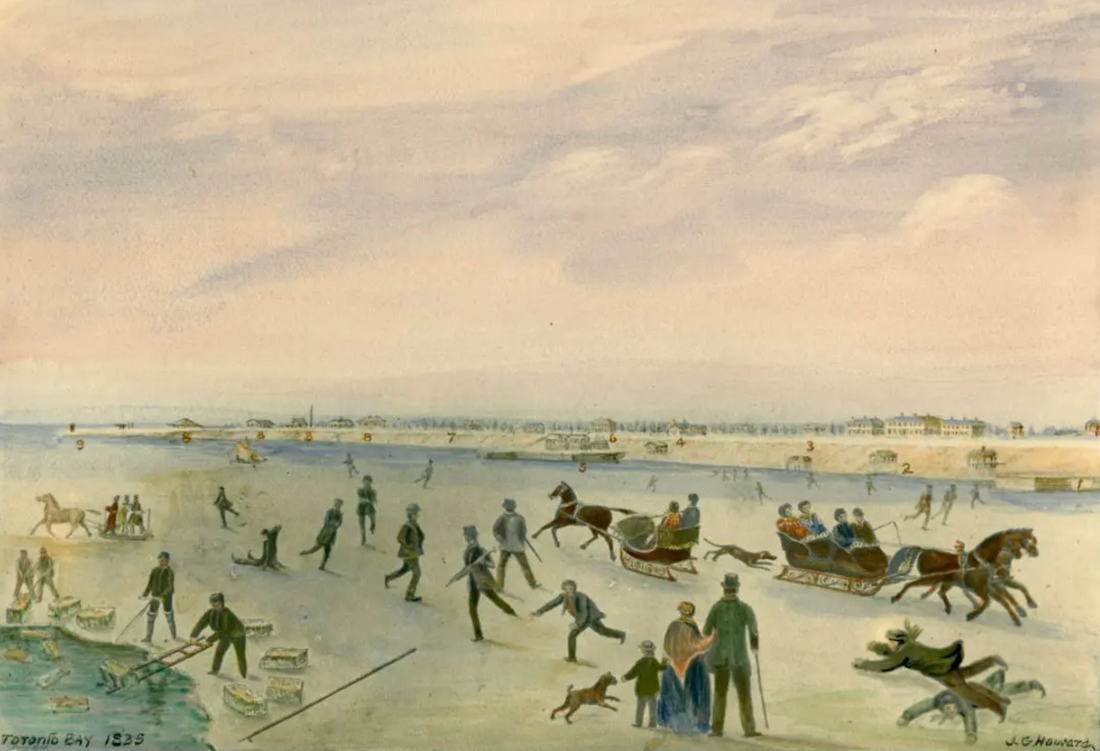
Boots & Blades: The Story of Canadian Figure Skating
Boots & Blades: the story of Canadian figure skating and how skating may have arrived in Canada. Take the opportunity to explore the roots of figure skating, beginning in the 1600s in the Bata Shoe Museum's online exhibition.
New economic growth in the 16th and 17th centuries meant that people had more time for leisure activities. Skating’s popularity grew exponentially during this period, especially in England, Russia, and northern Europe. Metal blades strapped onto boots replaced earlier bone and wooden sliders.

Image: These have a cut-out heart-shaped design. The bottom of the blades are honed with edges to allow the skater more control. North America, c. 1850-1860. Collection of the Bata Shoe Museum, P82.146. Image above: Toronto Bay, skating scene, by John George Howard, 1835. Courtesy of Toronto Public Library.
Pierre Dugua de Mons, an early explorer to New France, kept a diary of his experiences. In 1604, he settled on St. Croix Island in the Bay of Fundy. He noted: “During the winter some of the young men went hunting in spite of the cold weather. They went skating on ponds.”
Early settlers and explorers brought their skates with them to North America, stowing ice skates in their luggage. The letters of 18th-century British explorer and officer Thomas Anburey describe the immense popularity of the sport among British officers in North America. The sport was so popular, Anburey recalled, owing to “there being such a constancy and large extent of ice.” Stationed near Quebec City with the British Army’s 47th Regiment of Foot in 1789, Anburey remarked that “there are several officers in the regiment, who being exceedingly fond of it, have instituted a skating club, to promote diversion and conviviality.” Anburey mentions that Indigenous peoples also skated.

Image: Astra Burka’s custom Knebli boots with buckskin uppers, but cut slightly lower on the ankle than his earlier work. Fitted with “Taylor Special” John Wilson blades, 1961. Collection of the Bata Shoe Museum, P14.6.
Fast forward to today, Canada is a world leader in all aspects of figure skating. Canadian and international skaters train at Canadian facilities with renowned Canadian coaches. They wear Canadian-designed costumes, boots and blades, and they skate to music produced by Canadian music specialists. In this new age of globalism, cross-cultural exchange has skyrocketed.
Text and images courtesy of Bata Shoe Museum.
Read more and visit the online exhibition:
bootsandblades.ca
New economic growth in the 16th and 17th centuries meant that people had more time for leisure activities. Skating’s popularity grew exponentially during this period, especially in England, Russia, and northern Europe. Metal blades strapped onto boots replaced earlier bone and wooden sliders.

Image: These have a cut-out heart-shaped design. The bottom of the blades are honed with edges to allow the skater more control. North America, c. 1850-1860. Collection of the Bata Shoe Museum, P82.146. Image above: Toronto Bay, skating scene, by John George Howard, 1835. Courtesy of Toronto Public Library.
Pierre Dugua de Mons, an early explorer to New France, kept a diary of his experiences. In 1604, he settled on St. Croix Island in the Bay of Fundy. He noted: “During the winter some of the young men went hunting in spite of the cold weather. They went skating on ponds.”
Early settlers and explorers brought their skates with them to North America, stowing ice skates in their luggage. The letters of 18th-century British explorer and officer Thomas Anburey describe the immense popularity of the sport among British officers in North America. The sport was so popular, Anburey recalled, owing to “there being such a constancy and large extent of ice.” Stationed near Quebec City with the British Army’s 47th Regiment of Foot in 1789, Anburey remarked that “there are several officers in the regiment, who being exceedingly fond of it, have instituted a skating club, to promote diversion and conviviality.” Anburey mentions that Indigenous peoples also skated.

Image: Astra Burka’s custom Knebli boots with buckskin uppers, but cut slightly lower on the ankle than his earlier work. Fitted with “Taylor Special” John Wilson blades, 1961. Collection of the Bata Shoe Museum, P14.6.
Fast forward to today, Canada is a world leader in all aspects of figure skating. Canadian and international skaters train at Canadian facilities with renowned Canadian coaches. They wear Canadian-designed costumes, boots and blades, and they skate to music produced by Canadian music specialists. In this new age of globalism, cross-cultural exchange has skyrocketed.
Text and images courtesy of Bata Shoe Museum.
Read more and visit the online exhibition:
bootsandblades.ca
